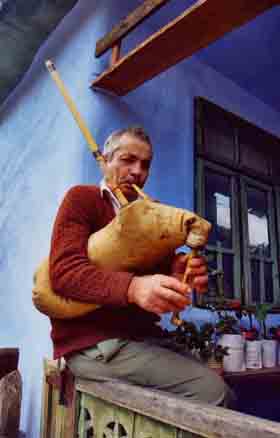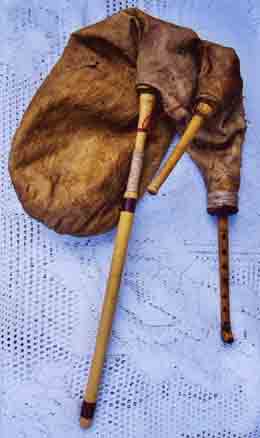|
|
|
|
András Csobotár, cimpoi player from Vizánta. Csobotár András vizántai csimpolyos. |
One of the Cimpoi made by András Csobotár. Egy Csobotár által készített csimpoly. |
|
Photographs © Ferenc Tobak 2005 |
|
|

|
|
||||||
|
|
||||||||
|
|
|
|||||||
|
By Ferenc Tobak This summer, starting in early June, I spent one month in Romania (Transylvania and Moldavia) looking for the villages that had been left out of what has now extended into my eighth year of research of the Hungarian Csángó bagpipers. My main target in Moldavia was to visit some these ‘neglected’ villages in the Tatros Valley and in the Gajcsána area in search of memories regarding past pipers. Years earlier, I had thoroughly explored and already visited the villages in the surrounding valleys of these communities and found that in those villages they are unaware of any still-living bagpipers. I thought it improbable that I would find another Hungarian piper, so my journey was really just to assure myself of this. This trip, however, served me with a surprise as big as any from my earlier visits*. I was already in my third week of traveling in Moldavia when I finally reached the southern-most Csángó village of Vizánta. I hoped that here I would learn something new, since this village was at the “end of the world”, and the area is famous for its Romanian pipers. At the edge of the village, I spoke to the first person who crossed my path and questioned the elderly gentleman about the local instrumental music traditions. When our conversation turned to questions about the ‘cimpoi’ the man’s answer was that he had three for sale! At first, I didn’t understand what he was talking about, what did he have three of for sale! It turned out that it was András Csobotár, the local bagpiper/bagpipe maker, who had greeted me at the border of Vizánta! I had not been prepared for this! As I quickly found out, he had learned to play the cimpoi from Miklós Atomi, his 72-year-old brother-in-law, who is still alive but not in good health. The local Mokány shepherds also spoke with great respect of Atomi’s father who had been an outstanding whistle (furulya) player. No collector/researcher had ever visited them because the village is far away from the popular folk-tourist targets, and those researchers who concentrate their efforts on the instrumental music of Moldavia somehow missed these musicians. The cimpoi’s had been ordered by a Romanian shepherd (i.e., not intended for tourists or city musicians). It was my good luck that the shepherd had not shown up for his instruments and Csobotár was happy to sell them to me. With this purchase, I have been able to compare three instruments from the same maker; I am able to study them in more detail and can more accurately determine the method of preparation, etc. The pipers from Vizánta play on cimpois with eight finger-holes. It is important that I call attention to the fact that our knowledge to date has been of two different types of bagpipes used by the Moldavian Csángó’s. This discovery has extended our knowledge with a new instrument: the eight finger-holed cimpoi. The pipers of the quarter million Hungarian Csángó Moldavians have been using three different forms of bagpipes even at the beginning of the 21st Century! These instruments are: • The “sip” has the same construction as the Hungarian “duda” (Nagypatak, Klézse, Külső-Rekecsin) • The “cimpoi” with six finger-holes (Ploszkucén) • The “cimpoi” with eight finger-holes (Vizánta) Regarding
the eight finger-holed cimpoi, this type of cimpoi is found in the
Romanian villages in the southwestern part of Bákó County, as well Vráncsa
County, and south of there in the valleys of the eastern foothills of the
Carpathians. Based on the
number of finger-holes, the structure of the instruments’ chanters
shows a similarity/relation to the Bulgarian bagpipe (gaida), but the
cimpoi does not have a ‘flea hole’, which is used to give
vibrato to the melody notes or to raise these notes a half tone.
The drone pipe is made of two pieces. Csobotár makes the instruments himself, the only one among the Csángó Hungarians who still knows how to make bagpipes. Especially interesting is his method of making the cimpoi, in as much as he, the instrument maker, goes to the forest to select the perfect elder branches for the pipes, and later, although seemingly barely altering them, he assembles them into an instrument. In Vizánta you can find one of the most simply made bagpipes in all of Europe. Csobotár makes tubes out of the elder branches by cleaning out the soft pulp, then dries them and pulls off the bark. He then cuts the tubes to measure, and burns in the holes of the chanter. At this point, the woodwork, for the most part, is complete. He makes the reeds out of local cane. He salts a goatskin then soaks it in whey for two weeks, which softens the bag and after which it will be ready to tie. Making one instrument is about three to four day’s work, without counting in the drying time.
I end my writing with the sad news that Mihály Dima, the cimpoi player from Ploszkucén, passed away on June 9, 2005. Rest in peace. Fort Bragg, CA August 12, 2005 * Katalin Juhász wrote about my 1998 and 1999 travels in the Hungarian “folkMAGazine” (Volumes 1999/4, 2000/1). In 2001 Gergely Agócs edited the book entitled “A duda, a furulya és a kanásztülök” (The Bagpipe, The Whistle and the Shepherd’s Horn) which included my writings about the bagpipers of Moldavia, “Fújják és táncolnak utána” (“They blow it and dance to it”).
|
||||||||
| For further information, please contact info@baratsag.com | ||||||||
| Back to top. | ||||||||
|
Június elejétõl egy hónapot töltöttem Romániában az immár nyolcadik éve húzódó csángó-magyar dudás-kutatásom eddig kimaradt falvainak felkeresésével! Kitûzött célom Moldvában néhány eddig "mellõzött" falu látogatása, valamint a Tatros völgyében, és a Gajcsána környékén valaha élt dudások emlékének felkutatása volt. A céljaimat képezõ településeket környezõ völgyek falvait évekkel korábban alaposan átfésültem, és ezen településeken még ma is élõ dudásról már nem tudtak . Valószínûtlennek tartottam hogy újabb magyar dudásra akadhatnék, utam tehát afféle önmegnyugtatásnak szántam. De ez az út is csak úgy mint a korábbiak* meglepetéssel szolgált, méghozzá nem is akármilyennel. Már harmadik hete jártam Moldvát amikor is eljutottam a legdélebbi csángó településre Vizantára. Bíztam abban hogy itt valami újat tapasztalhatok, mivel a település a "világ végén" van, és a környék híres a román csimpolyosairól. A falu határában az elsõ szembejövõ lelket megszólítottam, és a helyi hangszeres hagyományokról érdeklõdtem az idõs embertõl. Amikor a csimpolyra terelõdött a szó az illetõ válasza az volt hogy neki van három eladó! Elõször nem értettem mirõl beszél, mi van neki három eladó!
A helyi csimpolykészitõ-csimpolyos Csobotár András fogadott Vizánta hatarában! Erre nem voltam felkészülve.
Mint hamarosan kiderült sógorától, Atomi Miklostól (72) tanulta a csimpolyozást, aki ma is él, de nincs jó egészségben. Atomi édesapjáról mint kitûnõ furulyásról a helyi mokány pásztorok is nagy tisztelettel beszéltek. Soha gyüjtõ nem kereste fel õket, mivel a falu távol esik a népszerû folk-turista célpontoktól, és a moldvai hangszeres zenére öszpontosító kutatók figyelmét valahogy elkerülték ezek a zenészek. Az eladó csimpolyok sem valami városi zenész, hanem egy "oláh csobán" rendelésére készültek, aki szerencsémre nem érkezett meg a hangszerekért, tehát megvásárolhattam azokat. Igy három hangszert hasonlíthatok össze ugyanattól a készítõtöl, részletesebben tanulmányozhatom, pontosabban meghatározhatom az elkészítés módját, stb.
A vizántai "dudások" nyolc játszólyukú csimpolyon játszanak. Fontosnak tartom felhívni a figyelmet arra, hogy az eddig tudott, a moldvai csángók által használt két duda-típus újabb hangszerrel bõvül, a vizántai 8 játszólyukú csimpollyal.
A negyedmilliós moldvai magyar csángóság zenészei a XXI. század elején még három külömbözõ féle dudát tartottak kézben!
Ezek a hangszerek: a "sip" a magyar dudával egyezõ felépítésû hangszer (Nagypatak, Klézse, Külsõ-rekecsin) a hat játszólyukú csimpoly (Ploszkucén) a nyolc játszólyukú csimpoly ( Vizánta)
A nyolc játszólyukú csimpolyról bõvebben is írnék. Ez a csimpoly típus Bákó megye délnyugati részén, valamint Vráncsa megyében és attól délre a Kárpátok keleti lejtõjének völgyeiben a román falvakban elterjedt. A hangszerek a sípszár formájában a játszólyukak száma alapján a bolgáriai dudákkal mutatnak rokonságot, de a csimpolyokon nem ismerik a "bolhalyukat", ami a dallam hangjainak vibrálására vagy ezen hangok fél hangal való emelésére szolgál. A basszus csõ vagy burdon két darabból készül.
Csobotár saját maga készíti hangszerét, ami a csángó-magyaroknál egyedülálló. Különösen érdekes a csimpoly elkészítésének módja, mivel az illetõ az erdõben a csimpolynak való tökéletes bodza-ágakat, csöveket kiválogatja, majd szinte megmunkálás nélkül szereli össze azokat hangszernek. A bodza csöveket kitisztítja, szárítja, a kérgét lehámozza, majd méretre vágja, a sípszárra a lyukakat ráégeti. Ekkor a famunka lényegében elkészült. A sípoknak nádat használ. A bõrt sózza majd két hétre savóban áztatja amitõl a tömlõ megpuhul, amiután az kész lesz a bekötésre. Egy hangszer elkészítése 3-4 napi munka, a szárítási idõket nem beszámítva.
Az elkészítést illetõen az Európában készült dudák egyik legegyszerübbikével találkozhatunk Vizántában.
Szomorú hírrel zárom írásom. Június 9-én elhunyt Dima Mihály (1926-2005) a ploszkucéni csimpolyos. Nyugodjon békében.
Tobak Ferenc Fort Bragg CA 2005. augusztus 12.
* az 1998-as, és 1999-es útjaimról Juhász Katalin tollából jelent meg tudósítás a magyarországi "folkMAGazin"-ban (1999/4, 2000/1) . 2001-ben az Agócs G. szerkesztette "A duda, a furulya és a kanásztülök" címû tanulmánykötetben megjelent írásom a moldvai dudásokról "Fújják és táncolnak utána" címmel.
[ Home ] [ Moldavian Csángó Project ] [ Photography] [ Bagpipes ] [ Music ] [ Market Place ] [ Favorite Links ] [ Contact ]
|
||||||||


